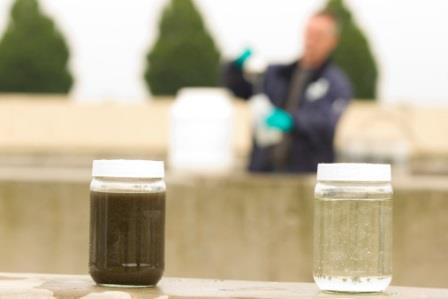

In this Edition
Construction
Management Specialists
111 Pine Street, Suite 1315
San Francisco, CA 94111
(415) 981-9430 (San Francisco office)
1663 Eureka Road
Roseville, CA 95661
(916) 742-1770 (Sacramento office)
9449 Balboa Avenue, Suite 270
San Diego, CA 92123
(619) 518-5648 (San Diego office)
8538 173rd Avenue NE
Redmond, WA 98052
(206) 571-0128 (Seattle office)
2063 Grant Road
Los Altos, CA 94024
(650) 386-1728 (South Bay office)
9705 Cymbal Drive
Vienna, VA 22182
(703) 268-0852 (Washington, DC office)
www.TBDconsultants.com
Astronomers are discovering hundreds of planets circling distant stars, and the often asked question is, ‘Is there life on any of them?’ To help answer that question, the first thing astronomers look for is any indication that water exists on the planet, because life as we know it requires water. Our planet is blessed with an abundance of water, so why are so many areas of the world suffering with water shortages? The first answer is that most of the water on the planet is found in the seas and contain salt, and it is fairly expensive to turn salt water into potable salt-free water using distillation or reverse osmosis technology. Secondly, we have a tendency to waste water (which can be read two ways, and both apply.) Consequently, just as there is a growing demand for Net Zero Energy buildings, there is also a growing movement towards Net Zero Water buildings.

There are two main objectives when pursuing this goal. The first is to capture as much rainwater for future use as possible, rather than just letting it run ultimately out to sea, where it will become costly to make usable. The second objective is to capture the water used in a building, treat it, and make it reusable, and that can be further subdivided into the capture and treatment of grey water and black water. Finding ways to reduce water usage is also very important, but water conservation and the use of low-flow fixtures has always been a part of green building, and we need to add to that.
Rainwater is not quite pure, because it can collect pollutants from the atmosphere, but treatments required to make it potable are effective and fairly cheap. Sometimes, regulatory requirements impose other restrictions, such as on a project in Seattle where chlorine was required to be added to comply with legislation, so proprietary water filters were then supplied at points of use to remove that same chlorine.

Grey water is water from laundry facilities, showers, sinks, and the like, and contains few impurities, and is therefore easy to treat. In regions where rainfall is plentiful, there may not be a need to recycle the water, and here it may be simply treated in artificial wetlands and allowed to percolate through landscape areas or swales and recharge the aquifer. Otherwise, it can be treated by processes, such as UV filtration and bio-filtration, and recycled for use in laundries or flushing toilets. While grey water can be treated to a condition suitable for potable use, regulation and people’s current perception would normally prohibit such practices at present.
Black water (from WCs, urinals, kitchen sinks and dishwashers) provides more of a problem for processing, requiring first separation of the solid waste, and then additional processing to clean up and remove organic compounds. Not to mention the additional psychological resistance to the reuse of such water. But since all the water on this planet has probably passed through some creature more than once in Earth’s history, there should be no real barrier to considering black water’s treatment and reuse. After treatment it can be brought to a state where it can be added to the grey water and follow that treatment path. That is opposite to the current situation, where grey water gets added to the black water and everything gets dumped into the sewer, requiring treatment plants to treat it all as black water. The use of composting toilets can significantly reduce the volume of black water in the first place.
Every building will require some input of relatively clean water in the form of rainwater, so in some regions achieving the goal of net zero water, without some reciprocal arrangement with areas of high rainfall may not be possible. But cooperation can make goals more achievable, including, for instance, having a central facility for treating grey and/or black water from a number of buildings in the same area, making the process more economical, while also saving the energy resources currently expended in the transporting of water to buildings and removing waste.
Among the projects working towards achieving Net Zero Water is a project at Eaton Residential College in Miami that, along with fitting out a portion of the building to implement net zero water usage, is also attempting to develop software that will automatically monitor the water quality, helping control the processing and report any problems. It will also study the socio-cultural acceptance of the technology, which is probably the aspect that is the biggest hurdle to cross, along with current legislative restrictions that have arisen largely because of those same biases.
Another hurdle in the adoption of Net Zero Water is financial. The burden of providing the infrastructure for water supply and waste treatment now becomes the responsibility of the building owner, rather than the utility. Even when looked at from a life-cycle perspective, it is often hard to justify, especially when utility rates may not reflect the true cost of the infrastructure. But if you take into account the cost to the planet, the scales can tip in the right direction and some municipalities offer financial incentive programs to help offset costs.
Greece is making the big headlines, but there are also other issues affecting markets worldwide. Here we take an overview of what is happening to the markets as we leave the second quarter of the year.
Windows 8 did not exactly excite the business community, but Microsoft is hoping that its new offering will restore the image of Windows as the innovative operating system of choice. Here we look at what the Redmond company's latest version is likely to bring us.
Design consultant: Katie Levine of Vallance, Inc.